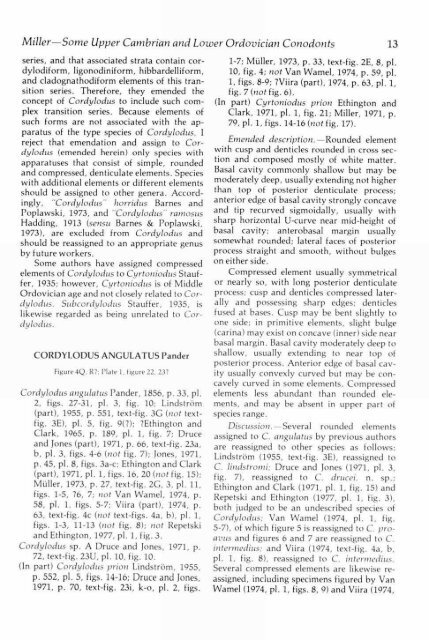View - KU ScholarWorks - University of Kansas
View - KU ScholarWorks - University of Kansas
View - KU ScholarWorks - University of Kansas
You also want an ePaper? Increase the reach of your titles
YUMPU automatically turns print PDFs into web optimized ePapers that Google loves.
Miller-Some Upper Cambrian and Lower Ordovician Conodonts 13<br />
series, and that associated strata contain cordylodiform,<br />
ligonodiniform, hibbardelliform,<br />
and cladognathodiform elements <strong>of</strong> this transition<br />
series. Therefore, they emended the<br />
concept <strong>of</strong> Cordylodus to include such complex<br />
transition series. Because elements <strong>of</strong><br />
such forms are not associated with the apparatus<br />
<strong>of</strong> the type species <strong>of</strong> Cordylodus, I<br />
reject that emendation and assign to Cordylodzis<br />
(emended herein) only species with<br />
apparatuses that consist <strong>of</strong> simple, rounded<br />
and compressed, denticulate elements. Species<br />
with additional elements or different elements<br />
should be assigned to other genera. Accordingly,<br />
-Cordylodus" horridus Barnes and<br />
Poplawski, 1973, and -Cordylodus - ramosus<br />
Hadding, 1913 (sensu Barnes & Poplawski,<br />
1973), are excluded from Cordylodus and<br />
should be reassigned to an appropriate genus<br />
by future workers.<br />
Some authors have assigned compressed<br />
elements <strong>of</strong> Cordylodus to Cyrtoniodus Stauffer,<br />
1935; however, Cyrtoniodus is <strong>of</strong> Middle<br />
Ordovician age and not closely related to Cordylodus.<br />
Subcordylodus Stauffer, 1935, is<br />
likewise regarded as being unrelated to Cordylodus.<br />
CORDYLODUS ANGULATUS Pander<br />
Figure 4Q, R7; Plate 1, figure 22, 237<br />
Cordylodus angulatus Pander, 1856, p. 33, pl.<br />
2, figs. 27-31, pl. 3, fig. 10; Lindstr6m<br />
(part), 1955, p. 551, text-fig. 3G (not textfig.<br />
3E), pl. 5, fig. 9(7); ?Ethington and<br />
Clark, 1965, p. 189, pl. 1, fig. 7; Druce<br />
and Jones (part), 1971, p. 66, text-fig. 23a,<br />
b, pl. 3, figs. 4-6 (not fig. 7); Jones, 1971,<br />
p. 45, pl. 8, figs. 3a-c; Ethington and Clark<br />
(part), 1971, pl. 1, figs. 16, 20 (not fig. 15);<br />
Müller, 1973, p. 27, text-fig. 2G, 3, pl. 11,<br />
figs. 1-5, 76, 7; not Van Wamel, 1974, p.<br />
58, pl. 1, figs. 5-7; Viira (part), 1974, p.<br />
63, text-fig. 4c (not text-figs. 4a, b), pl. 1,<br />
figs. 1-3, 11-13 (not fig. 8); not Repetski<br />
and Ethington, 1977, pl. 1, fig. 3.<br />
Cordylodus sp. A Druce and Jones, 1971, p.<br />
72, text-fig. 23U, pl. 10, fig. 10.<br />
(In part) Cordylodus prion Lindstrom, 1955,<br />
p. 552, pl. 5, figs. 14 -16; Druce and Jones,<br />
1971, p. 70, text-fig. 23i, k-o, pl. 2, figs.<br />
1-7; Müller, 1973, p. 33, text-fig. 2E, 8, pl.<br />
10, fig. 4; not Van Wamel, 1974, p. 59, pl.<br />
1, figs. 8-9; 'Mira (part), 1974, p. 63, pl. 1,<br />
fig. 7 (not fig. 6).<br />
(In part) Cyrtoniodus prion Ethington and<br />
Clark, 1971, pl. 1, fig. 21; Miller, 1971, p.<br />
79, pl. 1, figs. 14-16 (not fig. 17).<br />
Emended description. - Rounded element<br />
with cusp and denticles rounded in cross section<br />
and composed mostly <strong>of</strong> white matter.<br />
Basal cavity commonly shallow but may be<br />
moderately deep, usually extending not higher<br />
than top <strong>of</strong> posterior denticulate process;<br />
anterior edge <strong>of</strong> basal cavity strongly concave<br />
and tip recurved sigmoidally, usually with<br />
sharp horizontal U-curve near mid-height <strong>of</strong><br />
basal cavity; anterobasal margin usually<br />
somewhat rounded; lateral faces <strong>of</strong> posterior<br />
process straight and smooth, without bulges<br />
on either side.<br />
Compressed element usually symmetrical<br />
or nearly so, with long posterior denticulate<br />
process; cusp and denticles compressed laterally<br />
and possessing sharp edges; denticles<br />
fused at bases. Cusp may be bent slightly to<br />
one side; in primitive elements, slight bulge<br />
(caria) may exist on concave (inner) side near<br />
basal margin. Basal cavity moderately deep to<br />
shallow, usually extending to near top <strong>of</strong><br />
posterior process. Anterior edge <strong>of</strong> basal cavity<br />
usually convexly curved but may be concavely<br />
curved in some elements. Compressed<br />
elements less abundant than rounded elements,<br />
and may be absent in upper part <strong>of</strong><br />
species range.<br />
Discussion. -Several rounded elements<br />
assigned to C. angulatus by previous authors<br />
are reassigned to other species as follows:<br />
LindstrOm (1955, text-fig. 3E), reassigned to<br />
C. iindstromi; Druce and Jones (1971, pl. 3,<br />
fig. 7), reassigned to C. drucei, n. sp.;<br />
Ethington and Clark (1971, pl. 1, fig. 15) and<br />
Repetski and Ethington (1977, pl. 1, fig. 3),<br />
both judged to be an undescribed species <strong>of</strong><br />
Cordylodus; Van Wamel (1974, pl. 1, fig.<br />
5-7), <strong>of</strong> which figure 5 is reassigned to C. proavus<br />
and figures 6 and 7 are reassigned to C.<br />
intermedius; and Viira (1974, text-fig. 4a, b,<br />
pl. 1, fig. 8), reassigned to C. intermedius.<br />
Several compressed elements are likewise reassigned,<br />
including specimens figured by Van<br />
Wamel (1974, pl. 1, figs. 8, 9) and Viira (1974,
















